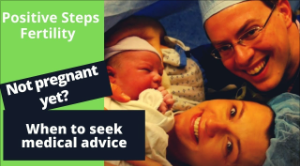If you’ve been told you have low AMH, it’s natural to feel worried about what that means for your fertility. AMH, or Anti-Müllerian Hormone, is one of the most commonly used tests in fertility medicine – but it’s also one of the most misunderstood.
In this post, I’ll explain what AMH is, what your results really mean, and whether low AMH should be a cause for concern. I’ll also share examples from my own practice – and even from my own family – so you can better understand the role AMH plays in fertility.
What Is AMH (Anti-Müllerian Hormone)?
AMH stands for Anti-Müllerian Hormone, sometimes called Müllerian Inhibiting Substance. In early fetal development, AMH determines whether or not a uterus develops. Later in life, it becomes a signal produced by very small eggs in the ovaries.
More specifically, AMH is made by the granulosa cells that surround eggs in tiny early-stage follicles. It is produced most in the pre-antral and small antral follicles (less than 4mm). Larger follicles (over 8mm) no longer make AMH.
That’s why AMH levels:
- Stay relatively constant across the menstrual cycle (unlike some other hormones)
- Provide a good estimate of how many small, developing eggs are present
- Serve as a marker of ovarian reserve (the remaining egg supply)
In simple terms: the higher your AMH, the more eggs you likely have left. The lower your AMH, the fewer eggs remain.
How AMH Levels Are Used in Fertility
Doctors often use AMH to predict how the ovaries will respond to fertility treatment. As a rough guide:
- For every 0.1 unit of AMH, you may be able to retrieve about one egg with IVF stimulation.
- This relationship is most reliable when AMH is between 0.1 – 1.0.
- At levels above 2.0, the correlation is less predictable.
- At extremely low levels (around 0.1–0.2), the ovaries may not respond at all.
I often explain it this way: eggs are like job applicants.
- If 20 people show up for an interview, you’ll probably find a good candidate.
- If 40 show up, even better.
- But if only one person comes, you’re stuck with whoever showed up – and they may not be the right fit.
That’s how egg numbers affect IVF outcomes. If another woman your age produces 23 eggs and you only produce 3, you’re working with one-eighth the yield – and that makes a big difference in pregnancy chances.
What Is a Normal AMH Level?
Different labs may report slightly different values, but these general guidelines (for women under 35) are often used in fertility medicine:
| AMH Level (ng/mL) | Interpretation |
| Over 4.0 | High (often PCOS) |
| 1.5 – 4.0 | Normal |
| 1.0 – 1.5 | Low Normal |
| 0.5 – 1.0 | Low |
| Below 0.5 | Very Low |
Important: AMH is a continuum, not a cutoff. The difference between 0.9 and 1.1 is minimal in real fertility terms. What matters most is how your AMH compares to your age group and how it fits into the bigger fertility picture.
What Do AMH Levels Really Tell You?
One of the most common misconceptions is that AMH tells you whether your eggs are “good” or “bad.” That’s not true.
AMH only measures quantity, not quality.
- If your AMH is 0.8, but the average for your age is 0.4, you’re actually ahead of the curve.
- If your AMH is 1.2, but the average for your age is 2.5, your number looks “normal,” but your timeline may be shorter.
A personal example: when my wife and I conceived our son Lucas, her AMH was about 0.3 – very low. Some people would call that perimenopausal. Yet Lucas is living proof that good eggs can still be there, even in small numbers.
Still, the lower the quantity, the more we begin to worry about quality as well.
Who Should Get an AMH Test?
The American Society for Reproductive Medicine (ASRM) notes that routine AMH testing isn’t needed for all women. For most women of normal reproductive age with no risk factors, the test won’t change management.
However, AMH testing may be useful if you:
- Have a mother who went through menopause early
- Have a sister who struggled with fertility
- Are personally worried about your ovarian reserve
Even then, remember: fertility is more than just egg count. AMH is one piece of the puzzle, not the whole picture.
Are There Symptoms of Low AMH?
Usually, no.
AMH can detect issues up to 10 years before menopause. By the time symptoms appear, AMH has usually been low for years.
When menstrual changes do happen, they’re often misunderstood. Many believe longer cycles are the first sign of running out of eggs. In reality, cycles often become slightly shorter first, before eventually becoming longer and more spaced out.
So for most women, low AMH is silent until ovarian reserve is already very diminished.
What Causes Low AMH?
The biggest factor is simply age. Women are born with all the eggs they will ever have, and their supply naturally declines over time.
Other contributors include:
- Smoking (accelerates egg loss)
- Chemotherapy or radiation
- Ovarian surgery that removes ovarian tissue
- Autoimmune disease, which can temporarily lower AMH if the immune system attacks the ovaries
Still, the most common reason for low AMH is the natural aging process.
Can You Increase Your AMH?
The short answer: probably not.
There’s a lot of talk about stem cell therapy, supplements, or “natural” treatments, but none have convincingly been shown to increase ovarian reserve…
One striking example: some pills imported from China were advertised as “herbs” that improved fertility. In reality, they contained human placental extract. The body thought it was pregnant, so FSH levels dropped – but the egg count hadn’t changed.
The reality is this: you’re born with every egg you will ever have. Some treatments may mask hormone levels, but they don’t regenerate eggs.
Other Ovarian Reserve Tests
AMH is one of the best markers of ovarian reserve, but it isn’t the only one. Doctors may also use:
- Antral Follicle Count (AFC): Ultrasound exam counting small visible follicles
- Day 3 FSH and Estradiol: Blood tests measuring hormones early in the cycle
- Clomid Challenge Test: A hormone test using Clomid to stress ovarian function
None of these is perfect, which is why fertility specialists often use a combination of tests to get the best picture.
Can You Still Get Pregnant With Low AMH?
Yes – absolutely, women with low AMH can and do get pregnant. My youngest son is proof. But low levels do make things harder, because fewer eggs mean fewer opportunities.
If you are lower and hope to have more than one child, timing becomes even more important. Fertility can drop another 40–50% over the 18–24 months it takes to go through pregnancy and breastfeeding. That’s why it’s important to talk early with a fertility specialist – not just about getting pregnant once, but about your long-term family goals.
FAQs About AMH and Fertility
Q: Can you increase AMH naturally?
A: Unfortunately, no proven treatment exists to increase levels or regenerate eggs. Healthy lifestyle choices like not smoking, maintaining a healthy weight, and managing stress can support fertility overall, but they won’t increase egg supply. Some supplements or remedies may temporarily change hormone readings, but they don’t restore ovarian reserve.
Q: What is a good AMH level for my age?
A: AMH naturally declines as women get older. For women under 35, levels between 1.5 – 4.0 ng/mL are often considered “normal,” while lower levels may suggest a reduced egg supply. What matters most is how your levels compare to the average for your age group, not just the number itself.
Q: Can you still get pregnant with very low AMH, like 0.3?
A: Yes, pregnancy is still possible. AMH measures egg quantity, not quality. Women with very low AMH sometimes conceive naturally, and many still respond to fertility treatments. Success depends on age, egg quality, and other factors – not AMH alone.
Q: Does low AMH mean I need IVF?
A: Not necessarily. IVF may be recommended if egg numbers are very low, but many women with low AMH still conceive through lower-tech treatments or on their own. A full fertility evaluation helps determine the best path for you.
Q: Should I test my AMH if I’m not trying to get pregnant yet?
A: It depends. Routine AMH testing isn’t recommended for all women, but it can be helpful if you have risk factors – like a family history of early menopause – or if you want a better sense of your reproductive timeline. Always interpret AMH alongside other fertility factors.
Final Thoughts
If you’ve been told you have low AMH, remember:
- Don’t panic. Low AMH doesn’t mean no chance.
- Quantity ≠ quality. Good eggs can still be there, even in low numbers.
- Planning matters. Especially if you want more than one child.
At Positive Steps Fertility, my goal is to give women clear, evidence-based answers so they can make informed decisions. If you’re worried about your AMH or ovarian reserve, schedule a consultation – we’ll help you understand the full picture of your fertility and your options for the future.
Next Steps You Can Take
- Learn more about female fertility testing.
- Watch my YouTube video on Low AMH.
- Explore the Parryscope® Test, Dr. Parry’s unique 20-minute fertility diagnostic.
If you’re ready for answers now, schedule a consultation with our team.




